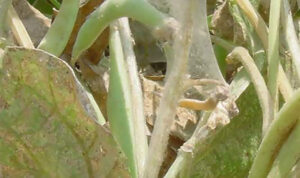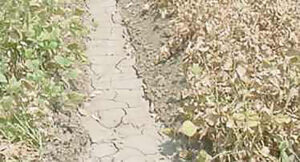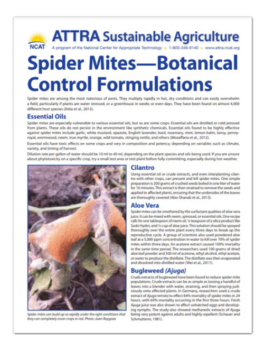Spider Mites—Botanical Control Formulations

Spider mites can build up so rapidly under the right conditions that they can completely cover crops in red. Photo: Juan Raygoza
By Justin Duncan, NCAT Agriculture Specialist
Spider mites are among the most notorious of pests. They multiply rapidly in hot, dry conditions and can easily overwhelm a field, particularly if plants are water stressed, or a greenhouse in weeks or even days. They have been found on almost 4,000 different host species (Attia et al., 2013).
Essential Oils
Spider mites are especially vulnerable to various essential oils, but so are some crops. Essential oils are distilled or cold pressed from plants. These oils do not persist in the environment like synthetic chemicals. Essential oils found to be highly effective against spider mites include garlic, white mustard, epazote, English lavender, basil, rosemary, mint, lemon balm, tansy, pennyroyal, wormwood, neem, true myrtle, orange, wild tomato, stinging nettle, and others (Mozaffaria et al., 2012).
Essential oils have toxic effects on some crops and vary in composition and potency, depending on variables such as climate, variety, and timing of harvest.
Dilution rate per gallon of water should be 10 ml to 40 ml, depending on the plant species and oils being used. If you are unsure about phytotoxicity on a specific crop, try a small test area or test plant before fully committing, especially during hot weather.
Cilantro
Using essential oil or crude extracts, and even interplanting cilantro with other crops, can prevent and kill spider mites. One simple preparation is 200 grams of crushed seeds boiled in one liter of water for 10 minutes. This extract is then strained to remove the seeds and applied to affected plants, ensuring that the undersides of the leaves are thoroughly covered (Abo-Shanab et al., 2013).
Aloe Vera
Spider mites can be smothered by the surfactant qualities of aloe vera juice. It can be mixed with neem, spinosad, or essential oils. One recipe calls for one tablespoon of neem oil, ¼ teaspoon of a silica product like Sodo Hydro, and ¼ cup of aloe juice. This solution should be sprayed thoroughly over the entire plant every three days to break up the reproductive cycle. A group of scientists also used powdered aloe leaf at a 5,000-ppm concentration in water to kill over 70% of spider mites within three days. An acetone extract caused 100% mortality in the same time period. The researchers used 100 grams of dried aloe leaf powder and 500 ml of acetone, ethyl alcohol, ethyl acetate, or water to produce the distillate. The distillate was then evaporated and dissolved into distilled water (Wei et al., 2011).

Characteristic webbing that is the telltale sign of spider mite infestation. field conditions that lead to spider mite epidemics: hot, dry, low humidity, and stressed plants. Photo: Rex DuFour, NCAT

Field conditions that lead to spider mite epidemics: hot, dry, low humidity, and stressed plants. Photos: Rex DuFour, NCAT
Bugleweed (Ajuga)
Crude extracts of bugleweed have been found to reduce spider mite populations. Crude extracts can be as simple as tossing a handful of leaves into a blender with water, straining, and then spraying judiciously onto affected plants. In Germany, researchers used a crude extract of Ajuga remota to effect 84% mortality of spider mites in 24 hours, with 69% mortality occurring in the first three hours. Fresh Ajuga juice was also shown to affect unhatched eggs and developing nymphs. The study also showed methanolic extracts of Ajuga being very potent against adults and highly repellent (Schauer and Schmutterer, 1981).
Mimosa (Albizzia julibrissin)
Crude ethyl alcohol extracts of the common weedy mimosa tree’s leaves and stems at a concentration of 10 grams per liter achieved almost 99 percent mortality of both adults and eggs of carmine spider mites. These alcohol extracts can be made at home using rum, vodka, or grain alcohol. Fill a quart-sized mason jar with freshly air-dried leaves and then pour alcohol over them, filling the jar. Close it tightly and let sit for six to eight weeks. When the infusion is complete, put about 10 ml of the liquid and one liter of distilled water in a spray bottle. Test spray one leaf to make sure the concentration is not phytotoxic. If the concentration is too high, further dilute it with distilled water. Repeat treatments as necessary (Wang et al., 2013).
Conclusion
Many plants, their crude extracts, or their essential oils can kill spider mites, but it is very important to manipulate the environment to be hostile to the spider mites. Since spider mites like hot, dry conditions, attempt to cool them down and increase humidity or even mist them, in addition to treating them with botanical pesticides.
ATTRA has a database of low-risk pesticides, including some botanicals. For more information, consult the ATTRA publication
Companion Planting & Botanical Pesticides: Concepts & Resources.
References
Abo-Shanab, A.S.H., K.S. Moursi, and H.S. Hussein. 2013. Effect of intercropping of Coriander (Coriandrum sativum L.) with Tomato (Solanum lycopersicum) on sucking pest management infesting tomato In Nubariya. El-Bheira Governorate, Egypt.
Attia, S., K.L. Grissa, G. Lognay, E. Bitume, T. Hance, and A. Mailleux. 2013. A review of the major biological approaches to control the worldwide pest Tetranychus urticae (Acari: Tetranychidae) with special reference to natural pesticides Biological approaches to control Tetranychus urticae. Journal of Pest Science. May.
Mozaffaria F., H. Abbasipoura, A.S. Garjanb, A.R. Sabooric, and M. Mahmoudvandd. 2012. Effects of ethanolic extract of Mentha pulegium on the two-spotted spider mite, Tetranychus urticae (Tetranychidae). Various Archives of Phytopathology and Plant Protection. July. Vol. 45, No. 11. p. 1347-1355.
Schauer, M and H. Schmutterer. 1981. Labiate Ajuga remota auf die Gemeine Spinnmilbe Tetranychus urticae Koch. Wirkung von Frischpreßsäften und Rohextrakten aus der Journal of Applied Entomology. 91(1-5):425-433.
Wang, D.D, F.L. Jia, J. Chen , W.J. Yu , and G.H. Dai. 2013. Acaricidal Activities of Albizzia julibrissin Durazz Extracts against Tetranychus cinnabarinus (Acari: Tetranychidae). Advanced Materials Research. Feb. Vol. 666, pp. 77-84.
Wei, J., W. Ding, Y.-G. Zhao, P. Vanichpakorn. 2011. Acaricidal activity of Aloe vera L. leaf extracts against Tetranychus cinnabarinus Boisduval (Acarina: Tetranychidae). Journal of Asia-Pacific Entomology. 14 (2011) 353-356.
Spider Mites —Botanical Control Formulations
By Justin Duncan, NCAT Agricultural Specialist
Published August 2016
©NCAT
IP522
Slot 548
This publication is produced by the National Center for Appropriate Technology through the ATTRA Sustainable Agriculture program, under a cooperative agreement with USDA Rural Development. This publication was also made possible in part by funding from the National Institute of Food and Agriculture, U.S. Department of Agriculture, grant award number 2013-51106-20970. ATTRA.NCAT.ORG.


